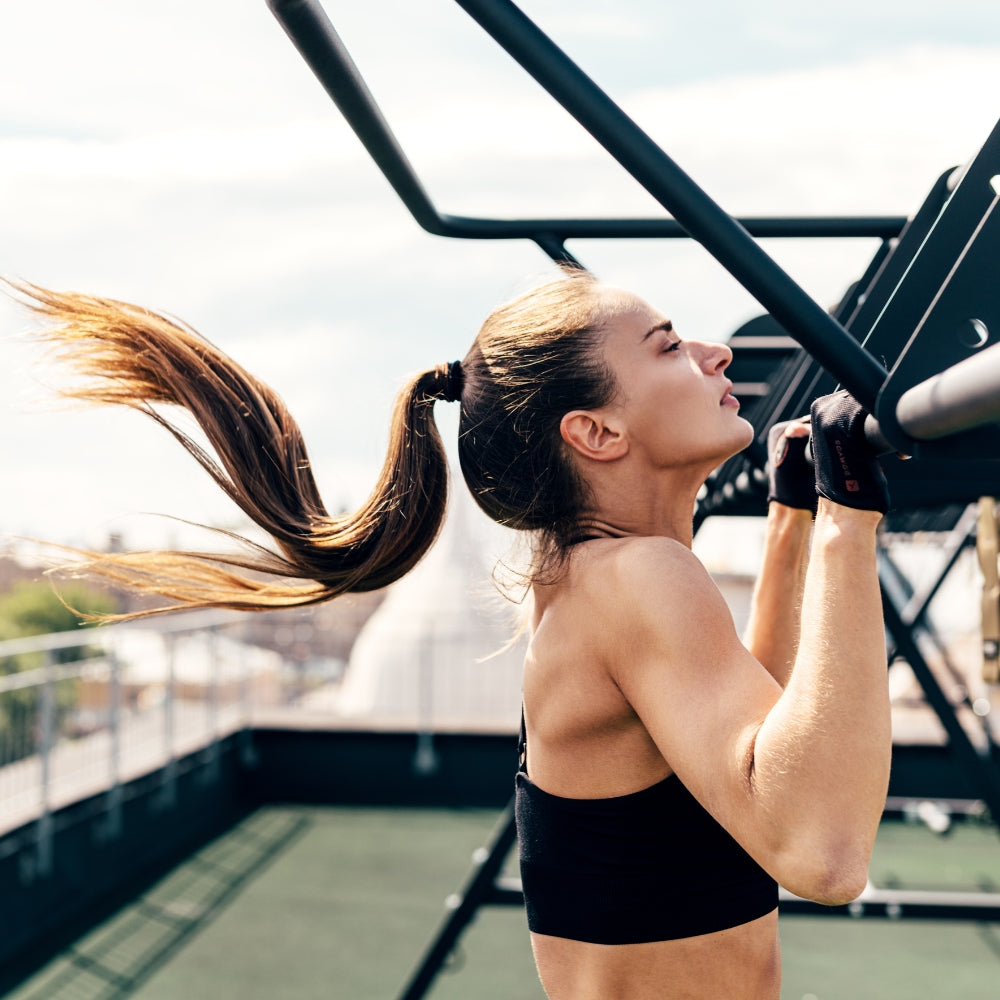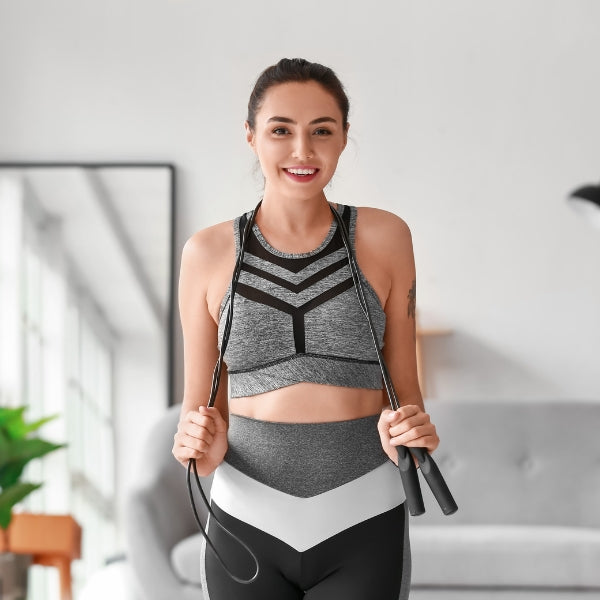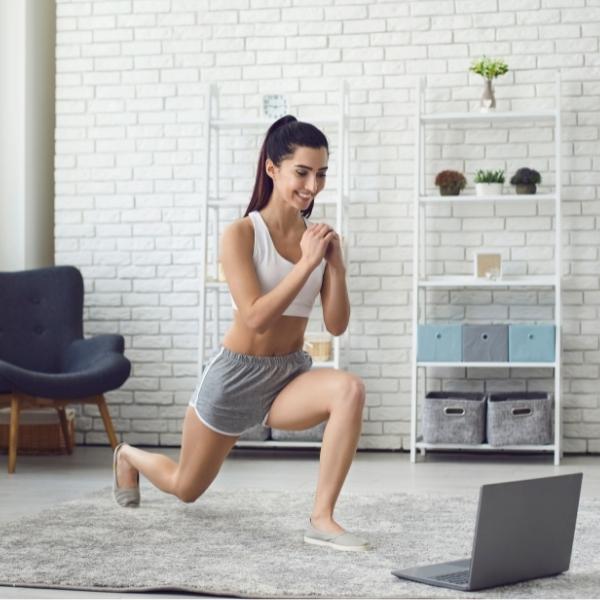Yoga Poses for Headache Relief
1. Setu Bandha Sarvangasana (A.K.A. Bridge Pose)
This pose stretches the chest, neck, and spine, along with stimulating abdominal organs. It is known to reduce anxiety, fatigue, backache, headaches, and insomnia (all of which can cause headaches). If you happen to have any type of neck injury, you may want to skip this pose unless practising under the supervision of a trained teacher.
To get in bridge pose, lie on your back on the floor with your knees bent and feet flat, arms down by your sides. As you exhale, press your feet into the floor and push your tailbone up, keeping your things parallel with one another. You may clasp your hands underneath your back and extend through the arms so that you are staying on the tops of your shoulders.
Be sure to keep your chin lifted through the duration of the pose, which you may hold anywhere from 30
seconds to one minute. When you are finished, slowly roll your spine back down to the floor while exhaling.

2. Marjaryasana (A.K.A. Cat Pose) and Bitilasana (A.K.A. Cow Pose or Dog Tilt Pose)
The benefits of cat pose include stretching the middle and upper back, as well as
shoulders. It is often used in conjunction with “cow pose,” which stretches the neck and front torso. Using these poses together provides a message for the spine and organs. Again, if you have a neck injury, you may want to skip this pose unless you are practising with a trained instructor.
To begin, get on your knees and hands (in a tabletop position), with your thighs and arms both perpendicular to your upper body (reaching straight towards the ground).
Your knees should be directly below your hips, and your wrists should be directly under your shoulders. As you inhale, slowly lift your tailbone and the front of your chest towards the ceiling, sinking your belly toward the floor for cow pose. You should be looking straight ahead. As you exhale, slowly go into cat pose by tucking your chin under and pushing your hands into the ground, lifting your
upper back toward the ceiling and tucking your tailbone under. Repeat these poses several times, alternating between the two over the course of each inhale and exhale.

3. Adho Mukha Svanasana (A.K.A. Downward Facing Dog Pose)
Downward Facing Dog is a great pose for building upper body strength, and it stimulates the brain and nervous system, improves memory, relieves stress, energizes the body, improves digestion, and more, which is probably part of the reason it is one of the most popular yoga poses “on the market!” The pose also deeply stretches the back, shoulders, hamstrings, calves, and hands, and it opens the chest. Those with carpal tunnel or other hand/wrist injuries may have difficulty with this pose, and if your headache is of the pounding variety, you may want to support your head on a bolster or block.
Starting on your hands and knees, spread your fingers and turn your toes under. As you exhale, slowly lift your knees off the floor, lengthening your tailbone up towards the sky.
Stretch your heels toward the floor, lengthening through your legs to stretch the calves and hamstrings. Be sure to keep the shoulders relaxed while pressing the hands into the floor, keeping pressure off the neck and shoulders. Keep the neck engaged and between the upper arms, as not to let it hang freely. Hold the pose for up to three minutes, breathing deeply and staying relaxed through the shoulders.

4. Balasana (A.K.A. Child’s Pose)
This is a calming pose and is often used after challenging poses in yoga classes to relax the body and rest. It gently stretches the lower back, hips, and thighs, massages the organs, and relieves stress. Those with knee injuries should be careful when practising this pose and only perform it while under the supervision of a trained professional.
While kneeling on the floor, touch your big toes together and spread your knees approximately hip-width apart. Slowly lay your chest down to the ground between your thighs, lengthening through the back and tailbone, lifting the base of your head away from your neck.
Lay your hands on the floor either along your sides or stretching out, as indicated in the picture.
You may stay in this pose as long as it is comfortable. Be sure to focus on taking long, deep breaths and ensure that you are staying relaxed.

5. Viparita Karani (A.K.A. Legs Up the Wall Pose)
Because most people are on their feet or sitting in an upright position, this pose is helpful in bringing blood flow back down into the belly and digestive organs. It helps to relax the mind and reduce fatigue, both of which may help your headache start to subside within minutes. Many yogis also claim that this is a “cure-all” pose that may help eliminate any ailment you are facing, from depression to varicose veins to high or low blood pressure.
Inversion poses such as this should be avoided if you have glaucoma or any other serious eye problem. If your feet begin to “fall asleep,” feel free to slide them down the wall (towards your pelvis) with your knees facing outward until you regain feeling.
For this pose, simply lie on your back with your tailbone against the wall (or as close as possible – it doesn’t have to be touching). Stretch your legs up the wall, and keep your arms at your sides. Keep your neck and back relaxed, and focus on taking long, deep breaths. Keep your legs firmly in place for as long as you’d like (typically not over 15 to 20 minutes). As simple as it looks, this pose may cause strain on your hamstrings if they tend to be tight. If this is the case, feel free to slightly bend your knees or use the edge of your bed or a chair so that you may bend your knees.

6. Janu Sirsasana (A.K.A. Head-to-Knee Forward Bend Pose)
Head-to-knee poses are calming and are known to relieve anxiety and fatigue, both of which often cause headaches. It stretches the shoulders, hamstrings, spine, and ground, and strengthens the muscles in the back. There are many modifications to this pose so that all levels may participate. You may choose to use a strap to help reach the foot or slightly bend your knee.
Be sure not to over-stretch any of your muscles, or you may have a problem much bigger than a headache!
Begin by sitting on the floor with both legs straight in front of you. Bend your right knee, resting your right foot on the inside of your left thigh or knee, whichever is more comfortable (the outside of your right leg should be resting on the floor – support it with a folded blanket if it doesn’t quite reach). Square your body to your left leg, pointing your belly button toward that knee (it should still be straight out in front of you). Slowly fold forward, lengthening your spine.
You may use a strap wrapped around your foot or reach around your foot with your hands if possible. Slowly roll back up after up to three minutes and repeat this stretch on the other side for the same amount of time.

7. Pavana Muktasana (A.K.A. Wind Relieving Pose or Knees-to-Chest Pose)
This pose helps to loosen muscles in the back, which encourages a rush of blood throughout the body. It also improves digestion and elimination, while lengthening the spine and stretching the back, reducing tension in the lower back. This pose is considered pretty safe for all skill levels, but be sure to check with your doctor if you have recently had any type of abdominal surgery or a hernia.
While lying flat on your back, inhale and bring both knees into your chest. Slowly wrap your arms around your knees, and hold on to your opposite elbows, forearms, wrists, or fingers, whichever you can reach most comfortably. Tuck your chin, slightly lengthening your neck onto the floor. Try to completely relax your back onto the floor so that it is flat. You may hold this pose as long as you’d like, ensuring that you are focusing on taking deep breaths and relaxing your entire body onto the ground.

8. Urdhva Mukha Svanasana (A.K.A. Upward-Facing Dog Pose)
Improving posture, stretching the shoulders, and relieving fatigue are just some of the headache-relieving benefits of this pose. Poor posture (especially for those who sit in an office chair all day) is a very common source of headaches, and this pose can counteract some of the effects caused by sitting in the same position day after day. People with back injuries or carpal tunnel may have difficulty with this pose, as it tends to put pressure on the lower spine and wrists.
While lying on the floor (face down) with your legs extended and the tops of your feet down, bend your elbows, placing your palms on the floor by your waist. As you inhale, slowly press your palms into the ground and raise your chest and upper legs off the floor by straightening your arms. Stay relaxed through the lower back and buttocks, and look straight ahead or tip your head back slightly, whichever is most comfortable and provides less strain for you. You may hold this pose for up to 30 seconds, and you may choose to sit back into child’s pose afterwards to relax the lower back.

9. Uttanasana (A.K.A. Standing Forward Fold)
This pose is known to lengthen the spine and hamstrings, strengthen the calves, and calm the brain, relieving stress and anxiety. It also stimulates most of the bodily systems, including the digestive and nervous systems. Having a tight back and hamstrings, both of which this pose is aimed at helping, are usually the result of long working hours, hours of commuting throughout the week, and sleeping in uncomfortable positions. Be sure to keep your hamstrings open and relaxed to reduce strain on the back while performing this pose, which you have likely done whether or not you’ve ever stepped foot in a yoga class. Those with back, leg, hip, or shoulder injuries should check with your physician before doing this pose.
Standing with your feet parallel and slightly less than hip-width apart, exhale while folding your body forward from your hip joints. Slightly bend the knees so that you can place your palms flat on the floor and your head towards your knees. Work towards straightening your legs by lifting the hips up slowly. It is common practice to grab your opposite elbow and let the head and arms “dangle” from the neck and shoulders. Some yogis also prefer to sway back and forth slightly and slowly. Hold this for four to eight breaths, and then slowly bend the knees and roll up to a standing position.

10. Savasana (Corpse Pose)
If you have had the pleasure of participating in a yoga class, you may be aware that most classes end with several minutes of relaxation. This pose is very popular for “unwinding” at the end of a yoga lesson, as it rejuvenates the body and reduces stress and tension. Some yogis may choose to begin their workout with this pose, as it calms the body and focuses the mind, both of which are important while practising yoga.
Although the pose looks pretty self-explanatory, it is important that you realize there is more to the pose than simply laying on the ground. The purpose is to completely relax your body and focus on your breathing. While lying on your back, allow all of your muscles to completely loosen, as if your body is falling asleep. Focus on breathing in and out through your nose, allowing your lungs to fully expand with each inhales and pushing all of your oxygen out with each exhale. Over the course of the pose, scan your body several times to ensure you are still completely relaxed. Focus on the muscles you may not realize are tense, such as your jaw, forehead, fingers, toes, etc. . . . Stay in this pose as long as you’d like. Once you would like to get up, be sure to do so slowly. Many instructors direct participants to begin to come out of the pose by wiggling their fingers and toes. Next, slowly bend at the elbows and knees, bringing your feet flat to the ground. Stay here for a couple of breaths. Eventually, push up to a seated position and take a few deep breaths before standing.





